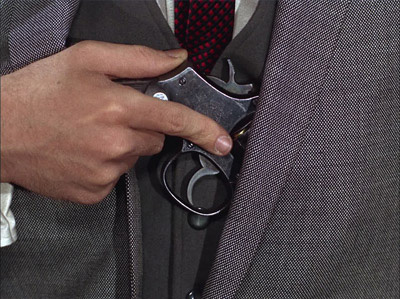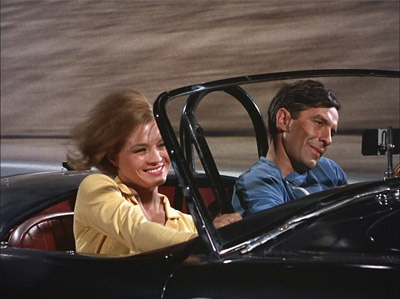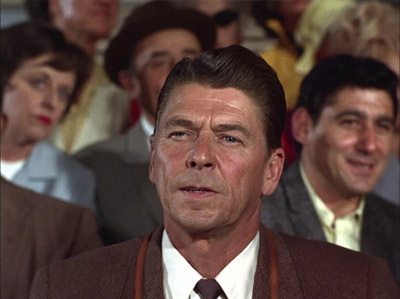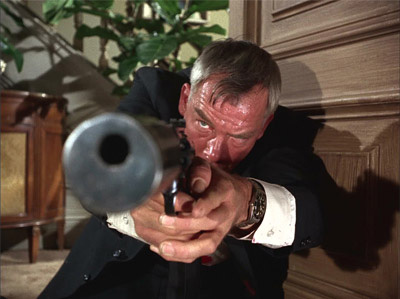| |
Siegel's heroes not only reject established society but they also reject any form of social relationships. The typical Siegel hero has no family background, no wife, no children, no personal friends. If he belongs to any social group it is usually an all- male one, held together not by any bonds of sympathy but by a shared goal. |
|
Alan Lovell, author of Don Siegel: American Cinema |
In the original short story of The Killers by Ernest Hemingway, his pair of assassins is described as Vaudevillian as in pertaining to the variety shows of the late 19th and early 20th century American stage. Uh... Lee Marvin? Vaudevillian? That's akin to casting Quentin Crisp as John Rambo in First Blood. The shoe most definitely does not fit. This simple literary vs. cinematic comparison tells us all we need to know about how markedly different and far removed the source material is from the eventual movie. You can read the 3,000 word short story in minutes and minimalist doesn't even begin to cover it. I do wonder how such works become classics. Again that powerful word 'context' and the even more powerful idea behind it are inevitably responsible. What director Don Siegel and screenwriter Gene L. Coon did with the story's bare bones is what matters. And this one's a cracker.
The Killers is famous for a number of reasons; it was to be the very first 'Made For TV' movie but ended up in cinemas due to its violence, a little too shocking for TV audiences in the early sixties; it was Ronald Reagan's first portrayal as a bad guy and his last acting part before he quit Hollywood for politics; President Kennedy was assassinated during its production, something that deeply affected leading lady Angie Dickinson, as she was rumoured to be one of the president's 'special' friends at the time. Its score is by a certain 'Johnny Williams' and yes, it's that John Williams, he of Jaws and Star Wars fame. Heavily advertised in some publicity incarnations as 'Ernest Hemingway's The Killers', the movie has no Hemingway in it at all. Director Don Siegel was keen to distance the movie from the source material but obviously someone figured Hemingway's name would sell a few tickets. The script was in good hands. To science fiction fans, the name Gene L. Coon should need very little introduction. Let's just say the following as respect is due; The Devil in the Dark, Space Seed and Arena. If you're not sure what those odd phrases mean then a Star Trek fan you are not. He invested the original Trek with humour, co-created Khan Noonien Singh as well as the charming and mock-adversarial banter between Spock and McCoy and came up with the concept of 'the Prime Directive' so it's fair to say his legacy is a significant one. Coon's script (partly co-written with his director) for The Killers is relatively straightforward. The movie was originally titled Johnny North after the car driving anti-hero but as the actual title on the film itself is the mouthful Ernest Hemingway's The Killers, it seems as if both director Siegel and writer Coon were outvoted.

Two hired killers, Charlie and Lee (Lee Marvin and Clu Gulager) track down an ex-racing driver (John Cassavetes) who is teaching engines at a school for the blind. Despite receiving ample warning to escape, he chooses to accept his fate. After the hit, Marvin is bothered that his quarry didn't run and tries to unravel the circumstances leading to the murder to his own satisfaction. Hit men (especially pre-paid hit men) are notoriously disinterested in the whys and wherefores of their profession (I imagine, of course. Only two of my friends are professional assassins so those two relationships don't represent a firm foundation for any sort of informed opinion). So, existentially speaking, director Siegel has something else to get his teeth into. If he shot the short story, it'd be over in ten minutes and I suspect an audience would be unimpressed. Obviously the artistic merits of Hemingway's short story are aspects that escape me and I will concede that I am the poorer for that.
Marvin sports the hit man's uniform, a classic design quoted back to us sevenfold in Reservoir Dogs; the 60s immaculate suit and tie with a crisp white shirt. In fact despite his many roles, Marvin lives in my imagination surgically attached to that 60s costume. His partner, as the editor of this site has already pointed out, is not a man Marvin would usually have the patience to put up with. He's health conscious, flip, needlessly aggressive and very young. The odd thing is that Gulager, with all his swagger and gum chewing toughness, manages to pull off the role convincingly because he's soulless behind the eyes and plays the preening, pretty boy with some detachment. He seems to genuinely enjoy his chosen profession. The violence meted out to femme fatale Angie Dickinson is foreshadowed (for the time, very unusually) by a cut to a handheld camera shot as he gets up from being sat down. The blow he strikes is unusually nasty. Gulager seems to relish the part, all bloody knuckles you can actually discern and that infectious enthusiasm seeps into the movie's very sprockets.

Lee and Gulager muscle their way through Johnny's associates and the movie takes on a flashback structure. Despite this, there's no problem recognising when we're back in time (and without the need of the wavy dissolve. All we need of course is Cassavetes as the signifier as he's already dead). While Johnny's out racing cars, enter Angie Dickinson, a blonde honey-trap who lures Johnny into a job organised by the big bad guy, mob boss Jack Browning played a little too plausibly by Ronald Reagan. I've never been convinced of Reagan's acting chops (his early career coasted on his then pretty boy all-American good looks) but given the fact he abhorred playing the bad guy, he's suitably chilling here aside from a few theatrical lapses by way of a few sidelong glances and a few choice "I'm the villain!" acting moments. Of course, the real man went on to be a bigger bad guy as far as left leaning politics was concerned. He went to war with corrupt unions and soon invited the disdain and distrust of unions everywhere. I can still recall that hilarious barbecue song 'I Believe' from the Not The Nine O'Clock News team that ended with the lyric "I believe that JR really loved Sue Ellen, I believe that things sound better when you're yellin'... I believe that the devil is ready to repent... But I can't believe Ronald Reagan is president..." Well, at the time, none of us could believe it.
If there is such a thing as a Lee Marvin persona, then here it is writ large. In fact this was the first iconic Lee Marvin role. He plays a smart killer with a surfeit of curiosity and he's as cold as his voice is sepulchral. In fact Marvin is so Lee Marvinesque that it seems he was born to play enigmatic, smart bruisers. If he has a truly scary but usually hidden demeanour, it's when he breaks a smile. It's a smile that says someone is about to get dangled out of a window or a bone is about to be broken. Even playing a punishingly inebriated and deranged cowboy in Paint Your Wagon doesn't dull the impact of what I came to know as Marvin's Point Blank identity. In The Killers he was just road testing the character until John Boorman came along. From the exhaustive and entertaining accompanying booklet, we find out that Marvin regularly turned up drunk until reigned in by Siegel. If he can be this menacing while intoxicated, I'd hate to see what kind of a monster he'd be with no physical impairment.

Despite the high-octane cast, The Killers was not an expensive movie. Some sets (like the gymnasium) look very stagey and rushed (I'm tempted to say 'televisual' but that's a cheap shot given what we know about the origins of this movie). But Siegel did shoot the car racing with a multi-camera set up and was lucky enough to get coverage of an honest-to-goodness crash which shows a car flip over multiple times and then erupt in flames. As you think "Have I just watched a man die?" a human figure appears, jumps out of the car in a wide shot from which Siegel then cuts into a shot of Cassavetes' legs emerging injured from the inferno. This is the very definition of opportunistic filmmaking. The only downside is that for one brief moment you are taken out of the movie simply because real life defies being nestled into the dramatic narrative. I applaud the editorial creativity either side that eased its inclusion but that crash was so real it jarred. For some reason the actual shot of the car bursting into flames had been shot at a Dutch tilt (with the horizon deliberately skewed) and the footage of the attendant emergency vehicles pitching up for real is softer than the pristine 35mm of the actual movie reinforcing its 'reality'. The process back projection shots are all too obvious given the enhanced resolution but as we are so aware of trickery nowadays, I can't see anyone really minding. It's akin to saying to your co-audience member "Hey, we're watching a film! It's not real!" There are two hilarious lapses in continuity in one scene that bear pointing out. After Reagan slaps Dickinson, she holds up her hand to the wrong cheek (the other has the red welt make up on it) and then as payback, Cassavetes punches Reagan right to left which inexplicably causes Reagan's right side of the mouth to bleed. The only slight quibble given the movie's highly stylised direction is its membership in the "If someone gets shot in a non vital place, they just put their palm on it and run away..." club. In reality of course, you fall to your knees in terrible, excruciating agony while you throw up your stomach lining in shock. Hey, hands up who really gives a toss about reality?
As this was originally made for the small screen and then promoted to the cinema, what we have here is two versions. As you can see from the comparison frame grab below, the 1.33:1 TV friendly frame has been cropped to 1.85:1 with the original shooting bearing this eventuality in mind and framing accordingly. Both play easy on the eye though I must say I found the 1.33:1 version a little more satisfying. While the print shows tramline scratches and odd speckles of dust and hair spoilage throughout, it still leaps off the screen as a superior transfer. The colours seem almost heightened and the sharpness in the close ups is worth a freeze frame and a Toy Story alien exclamation of "Ooooh!" Both Angie Dickinson and Lee Marvin's close ups just go to show that the camera just adores certain people. The level of detail and the overall sharpness just knocked me out.

The 2.0 PCM Mono track is very clear (there's a great deal of punch in the music) although of course, there is little or no separation. There are optional English SDH subtitles for the deaf and hearing impaired.
Reagan Kills: interview with New York Times bestselling writer Marc Eliot, author of 'Ronald Reagan: The Hollywood Years' (20' 47") HD
The first thing that strikes you about this interview is that its subject, the interesting and enthusiastic Marc Eliot, has been positioned in front of what must be the sun or at least a window with the sun streaming in. The back of the close up frame is blasted to hell and Mr. Eliot's face varies in and out of focus throughout. I'd like to think these interview-based extras are not difficult to do but I'm coming around to believe the opposite. The reflections in the subject's sunglasses are off-putting... Did no one actually look through a viewfinder? Regardless of these shortcomings, it's the content that's king and it's fascinating all the way through. Eliot says that Obama was "...a black president who looked like a white guy..." and it was appearance that got him the gig. That's a bold statement even if it's true. He applies the same criteria to Reagan – he looked presidential, what America thought the leader of the free world ought to look like. That's reason right there to eliminate it as any kind of criteria for power. It's fascinating to hear Reagan's excuse for starting off a Democrat and moving to the far right. It's exactly the same as Charlton Heston's; "I didn't leave the democratic party. The democratic party left me." For those interested in the politics behind Hollywood during Reagan's era, this is a good, solid extra feature.
Screen Killer: interview with Dwayne Epstein, author of 'Lee Marvin: Point Blank' (30' 45") HD
Once again the subject is sat next a window but this time the side lighting is not as severe. If you have any interest in Marvin, this extra is a small goldmine. One imagines reading Epstein's book for the whole story but the biographer is so in love with his subject and his stories about Marvin are so robustly entertaining, I can say that this is the stand out extra on the disc. Marvin was larger than life and some of the stories of his actions are encased in 60s and 70s amber. In other words, Marvin's behaviour would sit uncomfortably in today's hyper-celebrity culture. What's most surprising is the medical conclusion that was never reached after he was invalidated out of the Marines due to a severe war wound. Lee Marvin lived his entire career with what we now know as 'Post Traumatic Stress Disorder'. It's fascinating to know that he had the classic symptoms but just soldiered through it. Must order that biography.

Archive interview with Don Siegel (1984) from the French television series Cinéma Cinémas (10' 32") – HD but I think it originated on 16mm and ended up on 1" videotape (maybe)
"I'm a whore. I work for money..." Absolutely fascinating – again! I didn't realise Siegel second unit directed for so many big directors. This is where his own style of 'no style' originated. He also spoke about his 'montage' work which is where certain craftspeople were given the task of creating montages, the job usually now given to the assigned film editor. For some reason, in the time of the studio system, the editors just cut the picture and the montage editors cut the montages. It makes me smile to know that Don Siegel cut the opening montage of (drum roll)... Casablanca. Siegel regrets the label of 'action director' but was in no way unrealistic of where he stands professionally. I do wish he had been asked to take off his shades because the twinkle – so obvious in his words – should be seen in his eyes too. Seven minutes in, there is intrusive videotape damage for a minute or so. This extra has burnt in French sub-titles.
Gallery of rare behind-the-scenes images
Twenty-one stills including poster artwork and front of house cards. There is some repetition between the black and white stills and the hideously and jarring 'coloured' versions which look like they were done by hyperactive, colour blind children in kindergarten (why does the after-the-fact colourising of black and white need to be so cartoony? Maybe it's the style of the day.) Reagan wouldn't be thrilled to see the moment he strikes Angie Dickinson... twice. The stills originate from German publicity materials if my basic language skills don't let me down. It's an interesting extra if not exactly overflowing with content.
Reversible sleeve featuring the original poster and newly commissioned artwork by Nathanael Marsh
Didn't get to see this with the preview disc but can take a guess that Marsh's work adorns the front cover of the booklet – a classy graphic representation of a moment in the final scene.
Booklet featuring new writing on the film by Mike Sutton, extracts from Don Siegel’s autobiography and contemporary reviews, illustrated with original lobby cards
This is another class addition of this fine genre of accompanying material. The stand out for me from a filmmaker's perspective is the lengthy extract from Siegel's autobiography and reads like he tape-recorded all of his conversations. I accept this is a stylistic device but it is very insistent at convincing you the words he quotes are the literal truth. You have to keep reminding yourself that unless Siegel did record his conversations, these were recollections at best. But you know what? They are absolutely riveting recollections.
A great transfer of the movie that gave birth to the iconic Lee Marvin and a terrific example of the workmanlike professionalism of one of America's mostly unsung directors. Andrew Sarris, author of 'The American Cinema', was quick to praise his action credentials but Siegel, mostly by his own admission, was a director for hire who almost by happenstance has made some pretty important and thrilling movies. The Killers is right up there with his best work. Highly recommended for lovers of sunlit noir.
|